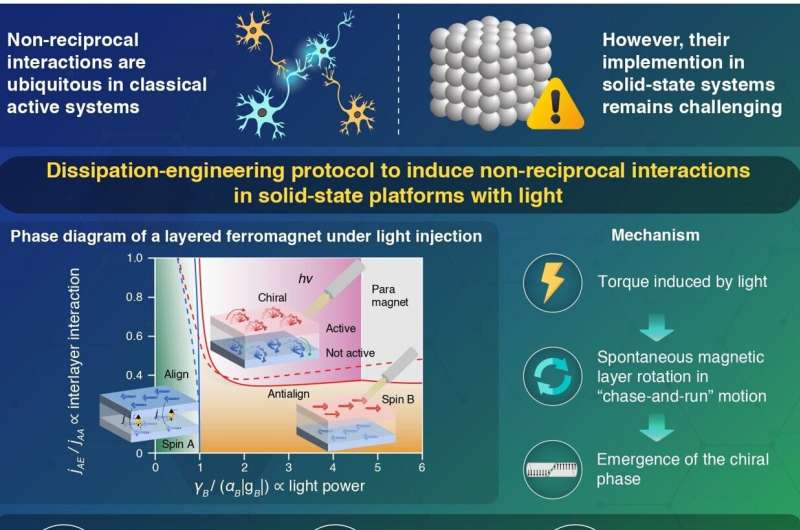Science
Researchers Unveil New Non-Reciprocal Magnetism Using Light

A research team from Japan has proposed a groundbreaking theoretical framework that demonstrates how light can induce non-reciprocal interactions in solids, effectively challenging the established principles of physics, particularly Newton’s third law. Led by Associate Professor Ryo Hanai from the Institute of Science Tokyo, the findings suggest new pathways in the study of materials science and potential applications in quantum technologies.
The researchers utilized a precision-tuned light frequency directed at a magnetic metal to generate a torque that drives two magnetic layers into a continuous, spontaneous “chase-and-run” rotation. Their study, published on September 18, 2025, in the journal Nature Communications, signifies a pivotal moment in non-equilibrium materials science.
Understanding Non-Reciprocal Interactions
In conventional physical systems, the law of action and reaction dictates that forces have equal and opposite reactions. However, in non-equilibrium systems, such as biological systems and active matter, this principle can be violated. Non-reciprocal interactions are prevalent in various natural phenomena, including the asymmetrical interactions between predator and prey or the dynamics of inhibitory and excitatory neurons in the brain.
The question posed by the research team was whether similar non-reciprocal interactions could be realized in solid-state electronic systems. The collaboration included Associate Professor Daiki Ootsuki from Okayama University and Assistant Professor Rina Tazai from Kyoto University.
“Our study proposes a general way to turn ordinary reciprocal spin interactions into non-reciprocal ones using light,” Hanai explained. The team illustrated that the well-known Ruderman–Kittel–Kasuya–Yosida (RKKY) interaction in magnetic metals could acquire non-reciprocal characteristics when exposed to specific light frequencies. This selective activation opens new decay channels for certain spins while keeping others off-resonant.
Implications for Future Technologies
The research team developed a dissipation-engineering scheme that leverages light to induce imbalances in energy injection among different spins within magnetic metals. This leads to non-reciprocal magnetic interactions. By applying this technique to a bilayer ferromagnetic system, they predicted a non-equilibrium phase transition, termed the non-reciprocal phase transition. This phase is characterized by one magnetic layer attempting to align with the other, while the opposing layer seeks to anti-align, resulting in a distinctive “chiral” phase with persistent rotational dynamics.
The findings suggest that the light intensity required to induce these non-reciprocal phase transitions is achievable with current experimental technology. This research not only provides a new method for controlling quantum materials with light but also connects concepts from both active matter and condensed matter physics.
“This work could lead to the development of new types of spintronic devices and frequency-tunable oscillators,” Hanai concluded. The implications of this research extend beyond theoretical explorations, hinting at exciting prospects for next-generation technologies in electronics and materials science.
The potential applications of non-reciprocal interactions in solid-state systems open a new frontier for innovation, illustrating how fundamental physics can lead to transformative technological advancements.
For further details, refer to the original study by Ryo Hanai et al in Nature Communications.
-

 Entertainment3 months ago
Entertainment3 months agoAnn Ming Reflects on ITV’s ‘I Fought the Law’ Drama
-

 Entertainment4 months ago
Entertainment4 months agoKate Garraway Sells £2 Million Home Amid Financial Struggles
-

 Health3 months ago
Health3 months agoKatie Price Faces New Health Concerns After Cancer Symptoms Resurface
-

 Entertainment3 months ago
Entertainment3 months agoCoronation Street’s Carl Webster Faces Trouble with New Affairs
-

 Entertainment3 months ago
Entertainment3 months agoWhere is Tinder Swindler Simon Leviev? Latest Updates Revealed
-

 Entertainment4 months ago
Entertainment4 months agoMarkiplier Addresses AI Controversy During Livestream Response
-

 Science1 month ago
Science1 month agoBrian Cox Addresses Claims of Alien Probe in 3I/ATLAS Discovery
-

 Health4 months ago
Health4 months agoCarol Vorderman Reflects on Health Scare and Family Support
-

 Entertainment4 months ago
Entertainment4 months agoKim Cattrall Posts Cryptic Message After HBO’s Sequel Cancellation
-

 World2 weeks ago
World2 weeks agoBailey Announces Heartbreaking Split from Rebecca After Reunion
-

 Entertainment3 months ago
Entertainment3 months agoOlivia Attwood Opens Up About Fallout with Former Best Friend
-

 Entertainment2 weeks ago
Entertainment2 weeks agoCoronation Street Fans React as Todd Faces Heartbreaking Choice





















